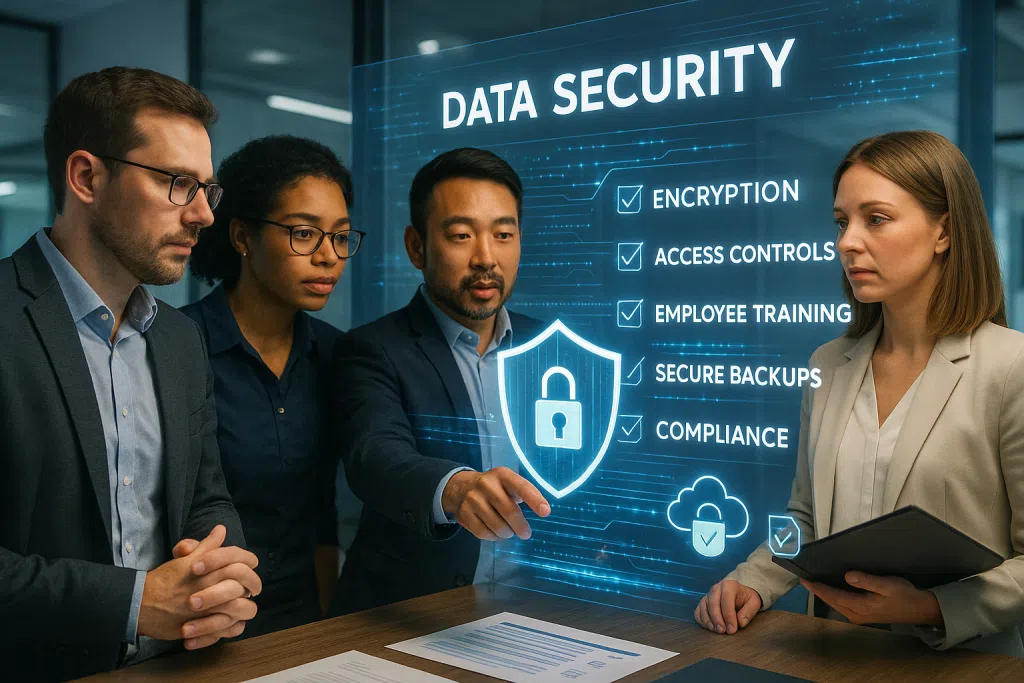Why Every SMB Needs a Robust Data Security Checklist
With ransomware and social engineering attacks on the rise, small and mid-sized businesses (SMBs) in regulated industries face an urgent need to secure client and patient data. The reality is stark: according to the Verizon Data Breach Investigations Report 2025, over 68% of cyberattacks now target businesses with under 250 employees, exploiting less stringent security practices and busy staff. Whether you manage a healthcare clinic in Princeton, a law office in Trenton, or a financial advisory service in the NYC metro area, meeting compliance requirements and safeguarding sensitive records is not optional; it’s foundational to your reputation and client trust.
But where should you begin? Establishing a thorough data security checklist demystifies this process. It provides a clear framework to identify gaps, implement controls, and respond to incidents, ensuring both state and federal regulations, like HIPAA, PCI-DSS, and GLBA, are met. A measured, actionable cybersecurity checklist brings consistency to daily IT operations and prepares your team for evolving threats.
For SMBs that don’t have a full-time IT department, building a data security checklist can initially seem overwhelming. However, even with limited resources, aligning your technology and processes with best practices unlocks a proactive, manageable path forward. Cloud-based tools, outsourced expertise, and integrated compliance solutions are now more accessible than ever.
Ready to see how a tailored checklist transforms your defense? Book an introductory meeting with Blueclone Networks to get started: Book an introductory meeting
Mapping the Essential Steps: Building Your Comprehensive Data Security Checklist
Constructing an effective data security checklist requires understanding both the technical and procedural layers necessary for true protection and compliance. Cyber threats often exploit overlooked weaknesses, be it a misconfigured firewall, weak authentication, or staff untrained on phishing attempts. Before you start checking boxes, map a clear inventory of sensitive data assets, users, and connectivity points, including remote work endpoints that have surged post-pandemic.
First, document where personally identifiable information (PII), protected health information (PHI), payment data, and proprietary files reside. These could be in workstations, cloud drives like Microsoft 365, practice management software, or local servers. Understanding data flow, how information enters, moves, is stored, and exits your organization, is the backbone of any IT compliance checklist. This transparency is especially vital for firms in healthcare and finance, where regulations demand ongoing reporting and auditability.
Second, set a baseline for access controls: who gets access to what, and why? Ensure that privilege levels match roles, using the principle of least privilege. Multi-factor authentication (MFA) should be enforced for all business-critical accounts, reducing the risk of breach via compromised credentials. Modern solutions can automate user provisioning and conduct periodic reviews, alerting you to out-of-date or orphaned accounts.
Third, develop or update an inventory of hardware and software across your network. Asset management tools can help here, flagging unauthorized devices or unpatched software versions. SMBs often fall victim to attacks because of overlooked assets, such as a forgotten remote desktop port on an old workstation. Routine vulnerability scanning, part of any robust cybersecurity checklist, identifies these hidden weaknesses so they can be addressed before attackers exploit them.
Fourth, embed cybersecurity compliance into your policies and employee handbook. Regularly communicate requirements for password hygiene, mobile device use, data sharing, and remote work practices. Mandate yearly cybersecurity training, including simulated phishing exercises. According to an IBM Security report, companies that invest in ongoing staff awareness see fewer successful attacks.
Building a culture of compliance goes beyond technical fixes. Documenting procedures for onboarding, offboarding, and incident response ensures continuity and accountability, especially as staff turnover or duties shift. For complex regulatory environments, consider leveraging automated IT compliance platforms that provide real-time dashboards for auditors and executives.
To summarize, your initial checklist should include:
- Data inventory and classification
- Access and privilege management
- Asset identification and tracking
- Vulnerability management and patching
- Security policy documentation and training
- Third-party and supply chain risk reviews
- Disaster recovery and incident response documentation
Midway through your implementation? Don’t hesitate to seek expert guidance. Book an introductory meeting with Blueclone Networks to evaluate your current security posture: Book an introductory meeting
Technical Controls That Should Top Every SMB’s Data Security Checklist
Technical controls serve as the backbone of any effective data security checklist, offering a first line of defense against breaches and a means to reduce compliance risk. For SMBs with lean IT teams or co-managed partners, automation and integration are vital, manual processes can’t keep pace with modern threat vectors.
A layered security approach, often referred to as “defense in depth”, remains the gold standard. This includes a combination of network, endpoint, and cloud protections, working in conjunction:
Next-Generation Firewalls and Segmentation:
- Modern firewalls do more than block ports; they analyze incoming and outbound traffic for suspicious patterns, enforce application-specific rules, and can segment networks to isolate sensitive workloads. Network segmentation becomes especially important for healthcare and legal IT environments, ensuring records are siloed from guest or public access zones.
Secure Access Service Edge (SASE)
- Modern cybersecurity incorporates SASE, which combines network security functions and wide-area networking (WAN) capabilities into a single, cloud-delivered service that provides secure connections to all endpoints regardless of their location (i.e. main office, public Wifi, hotel, home, remote locations, etc.)
The right SASE solution, properly configured, will simplify IT, remove dangerous VPN connections, and allow for greater flexibility, scalability, and simpler management compared to legacy hardware solutions.
Endpoint Detection and Response (EDR):
- With remote work and BYOD expanding attack surfaces, deploying lightweight EDR tools is now essential. These platforms monitor and contain threats in real time, often providing forensic logs for post-incident investigation. EDR also helps overcome the gaps legacy antivirus leaves exposed.
Email Filtering and Encryption:
- Email remains the top delivery vector for business malware and phishing attacks. Advanced filters block suspicious links and attachments, while encrypted email gateways protect sensitive content in transit. For regulated organizations, archiving solutions ensure that emails are stored in accordance with retention policies.
Secure Cloud and SaaS Application Configuration:
- It’s not enough to adopt Microsoft 365, Google Workspace, or other cloud platforms, settings must be optimized for compliance, restricting file sharing, access control, and data residency. Automated tools can continuously verify configurations against industry and regulatory benchmarks. For firms in the process of AI integration, this is especially critical as LLM tools can potentially surface or process confidential data.
Automated Patch Management:
- Attackers routinely scan for unpatched assets as easy entry points. Automated solutions inventory devices and deploy updates, prioritizing fixes for active threats (“zero days”). Documenting this as part of your cybersecurity checklist proves to auditors that preventive controls are operational.
Backup and Disaster Recovery:
- Regular, encrypted backups stored offsite or in secure cloud vaults are not just smart business, they’re often mandated by HIPAA and other frameworks. Test your restore procedures regularly; a backup is only useful if it can be reliably recovered when needed.
Multi-Factor Authentication (MFA) Everywhere:
- Implement MFA for all administrators, email, VPN, and remote access accounts. For legal and healthcare environments, extending MFA to client and patient portals can further prevent unauthorized access.
Monitoring and Alerting:
- Centralized log collection and security information and event management (SIEM) tools empower rapid detection and escalation of anomalous activities. Automated alerting cuts response times, often thwarting attacks before they escalate.
The cost and complexity of these controls have dropped in recent years, thanks to managed service platforms tailored to the SMB market. Even if you outsource some functions, ensure your IT compliance checklist holds vendors accountable for meeting your standards.
For a detailed breakdown of technical safeguards and regulatory mapping, resources like the Center for Internet Security (CIS) Controls 2024 Edition offer actionable benchmarks. According to the CIS, even basic control implementation can cut successful attacks by up to 85%.
Process Controls and Policies: The Foundation of Cybersecurity Compliance
Technical tools alone cannot guarantee compliance; controls and policies that define the “how, when, and why” are just as important as firewalls and backups. Documented and enforced process controls transform technology into reliable, repeatable, and audit-friendly practices.
Acceptable Use and Internet Policy:
- Set clear guidelines for device, network, and web usage. Define which websites, software, or cloud services are allowed. This reduces exposure to malicious downloads and shadow IT, unsanctioned apps that can leak sensitive data.
Password Management:
- Move beyond simple password policies. Mandate minimum length, prohibit sharing, and require periodic changes. Password managers can remove friction, allowing staff to maintain unique, strong credentials without frustration.
Physical Security:
- Control access to offices, storage rooms, and data closets. Issue keycards based on job needs and collect credentials immediately upon employment changes. Lock file cabinets containing paper records.
Incident Response Planning:
- When an attack or breach occurs, having a documented incident response plan allows your team to act swiftly. Assign responsibilities, maintain up-to-date contact lists, and describe step-by-step procedures for detection, containment, notification, and recovery. Many compliance standards now require that these plans be tested at least once per year.
Data Retention, Archiving, and Disposal:
- Define how long personal, financial, or health data is kept. Securely erase or destroy records according to retention policies. For example, HIPAA requires healthcare data to be preserved for at least six years in most cases.
Vendor Risk Management:
- Your data is only as secure as your weakest link, including third-party providers. Conduct routine due diligence, review audit reports (SOC 2, for instance), and document security agreements.
Change Management:
- Formalize how software updates, hardware upgrades, or new applications are evaluated and deployed. Change requests should be logged, reviewed, and approved to reduce errors that can introduce risks.
Documenting these policies, incorporating regular training, and requiring staff acknowledgment builds organizational muscle memory. According to Gartner’s 2025 Cybersecurity Predictions, SMBs with formal, enforced policies are four times less likely to face data compliance penalties.
Ensuring Your Cybersecurity Checklist Keeps Pace with Evolving Risks
Cybersecurity is not a set-and-forget operation. Emerging threats, evolving regulatory requirements, and technology migrations (such as increased adoption of cloud or AI services) mean every organization’s data security checklist should be revisited at least quarterly.
Ongoing Vulnerability Assessments and Penetration Testing:
Regular vulnerability scans and “red team” exercises shed light on unseen weaknesses in your applications and infrastructure. Automated scanning solutions paired with annual professional penetration tests create a robust feedback loop.
For SMBs using co-managed IT or managed services providers, they require scheduled reports verifying the status of open vulnerabilities, patch compliance, and remediation timelines. Executives should receive summary dashboards while IT teams focus on tactical details.
Compliance Audits and Documentation:
Regulations like HIPAA, PCI-DSS, and FINRA demand both proof of technical controls and documented evidence that policies are enforced. Periodic internal audits, supported by external expert reviews, help demonstrate readiness in advance of regulator or customer audits.
Simulated Incident Drills:
Schedule tabletop exercises or simulations where staff role-play responses to events such as ransomware outbreaks or lost devices. This not only tests the technical aspects but also strengthens muscle memory for decision-makers.
User Awareness Refreshers:
Threats evolve quickly, so annual or semi-annual refreshers keep staff alert to new tactics. Customizing content to your environment (such as finance-focused phishing lures or healthcare privacy scenarios) increases engagement and minimizes “check-the-box” fatigue.
Evaluating Cloud and AI Risk:
Rapid moves to the cloud and adoption of AI tools present significant benefits, but reshape your attack surface. Review and tune SaaS application settings, data residency, sharing controls, and API integrations on a regular basis. For AI projects, make sure your data security checklist includes input/output monitoring, logging, and access governance.
With the rapid pace of change, consider engaging partners who specialize in cybersecurity compliance and IT risk management. Blueclone Networks tracks regulatory and technical trends and can help your organization anticipate, not just respond to, what’s next.
Tailoring Your IT Compliance Checklist to Industry and Business Realities
No single data security checklist fits every SMB. Unique regulatory requirements for healthcare, legal, finance, and pharmaceutical organizations shape the specific controls, tools, and processes needed.
Healthcare Providers:
HIPAA-mandated safeguards include strict access logging, audit trails, and policies covering both electronic and paper records. Encryption is required not only in transit but also at rest, including on mobile devices and backups. Frequent training on privacy rules and breach notification protocols is essential.
Legal Firms and Professional Services:
Law firms must secure both client files and privileged communications. Retainer and trust accounting data bring added oversight. Document archiving policies, secure client portals, and stringent controls over mobile access are central. Regulations like the ABA Cybersecurity Resolution drive best practices within the legal field.
Financial Services and CPAs:
Regulations such as GLBA and SEC guidelines place extra scrutiny on data classification, retention, and regular risk assessments. Encryption of both transactional data and customer communications, strong vendor risk assessment, and real-time monitoring of wire transfer requests are all necessary.
Pharmaceutical and Medical Research:
In addition to HIPAA, organizations handling clinical trial or drug development data may face FDA 21 CFR Part 11 requirements, covering electronic signatures and auditability. Controlling access to lab equipment networks and segmenting research environments from business IT systems is key.
For organizations integrating AI:
- Ensure LLM (large language model) and automation tools are configured to prevent data leakage.
- Monitor input and output to avoid exposure of confidential or regulated information.
- Establish data governance policies for AI-driven workflows.
While fundamentals overlap, tailoring your IT compliance checklist to these nuances helps avoid fines, reputational damage, and legal liability. Partnering with a provider fluent in your industry’s regulatory context, like Blueclone Networks, removes guesswork and accelerates audit readiness.
Frequently Asked Questions About Data Security Checklists
Every SMB should focus on ongoing vulnerability scans and patching, strong password management with MFA, accurate data and asset inventories, documented policies for data retention and incident response, and regular employee training sessions combined with simulated phishing.
Staying compliant relies on aligning checklist items with published regulatory frameworks and using audit-friendly documentation methods. Many organizations choose to partner with specialists who have expertise in regulated environments, as they can map technical and procedural controls directly to regulatory language and best practices.
Human error is a leading factor in most breaches. A critical element of the checklist should be regular, updated staff training targeting current phishing and social engineering threats, secure data handling, and policy review. This reduces the chance of accidental exposure or unauthorized data sharing.
A data security checklist must evolve alongside your business and the broader threat landscape. At a minimum, it should be reviewed quarterly, more frequently if new software, staff, or compliance obligations are added.
Decisions should be based on both business needs and regulatory context. Look for tools that provide automation, centralized visibility, and integration with your existing workflows. Involving a managed service provider experienced in your industry can help match solutions to compliance requirements and budget constraints.





